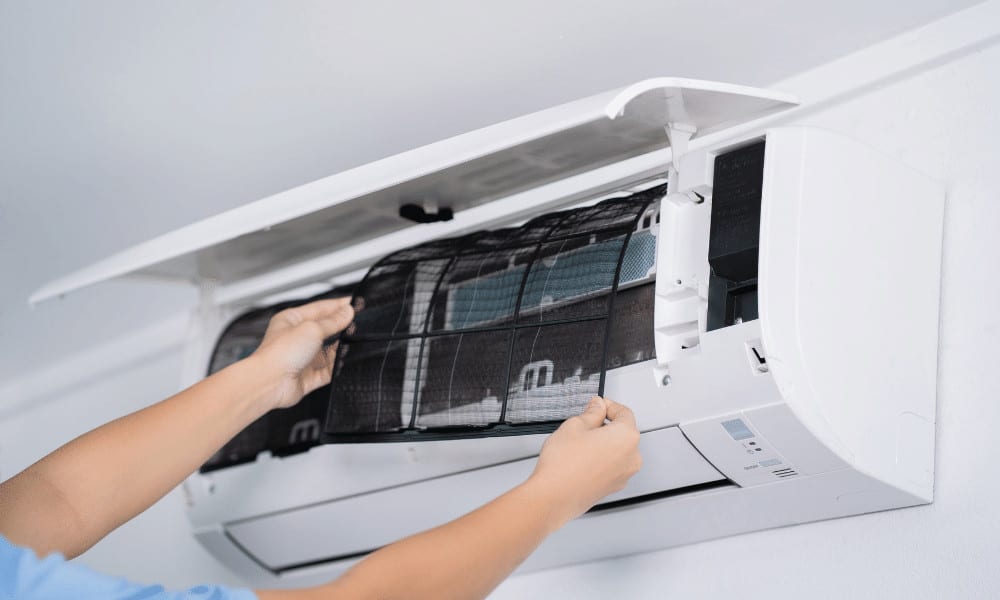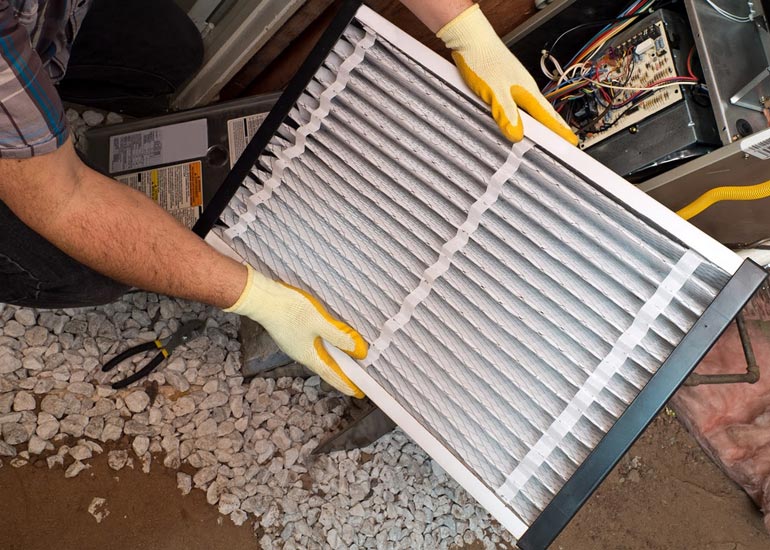Can You Run Ac Unit Without Filter

One of the most common dilemmas homeowners face during the hot summer months is discovering their AC unit is running without a filter, or realizing they've forgotten to replace it for far too long. The immediate question is: Can I still run the AC? The short answer is generally no, but understanding why is crucial. Let's walk through the potential problems, how to diagnose them, and what you can do before calling a professional.
Understanding the Role of Your AC Filter
Before we dive into the troubleshooting, let's quickly recap why your AC filter is so important. It's not just about keeping your indoor air clean (although it certainly helps with that!). The primary function of your AC filter is to protect the internal components of your air conditioning system. These components, especially the evaporator coil, are sensitive and expensive to repair or replace.
The filter traps dust, pollen, pet dander, and other airborne particles before they can reach the evaporator coil. Without a filter, these particles accumulate on the coil, reducing its ability to absorb heat and cool your home effectively. This leads to:
- Reduced cooling efficiency.
- Increased energy bills.
- Potential damage to the AC unit.
- Poor indoor air quality.
Identifying the Problem: Running AC Without a Filter
Okay, you suspect your AC has been running without a filter. Here's how to confirm and assess the situation:
Step 1: Visual Inspection of the Filter Slot
First and foremost, check the filter slot. Is it empty? Is there a grossly clogged filter that hasn’t been changed in months (or years!)? This is the easiest and most obvious confirmation.
Safety First: Before proceeding with any further inspection, turn off the AC unit at the thermostat and, ideally, at the breaker. This prevents any accidental start-up while you're working on it.
Step 2: Inspect the Evaporator Coil
This is the next crucial step. The evaporator coil is usually located inside the indoor unit of your AC system. The location varies depending on your system type (furnace-mounted, wall-mounted, etc.).
How to Find It: Refer to your AC unit's manual for the precise location of the evaporator coil. If you don't have the manual, search online using your AC unit's model number.
What to Look For: Once you've located the coil, visually inspect it for dust and debris accumulation. Use a flashlight to get a better view. If it looks like a furry, dusty mess, you've definitely been running the AC without adequate filtration.
Step 3: Check for Performance Issues
Even if the coil doesn't look terribly dirty, consider whether you've noticed any of these symptoms:
- Weak Airflow: Is the air coming from the vents noticeably weaker than usual?
- Inconsistent Cooling: Is your home not cooling evenly, or taking longer to reach the set temperature?
- Increased Energy Bills: Have you noticed a spike in your electricity bill without any other obvious explanation?
- Strange Noises: Are you hearing any unusual noises coming from the AC unit, such as rattling, hissing, or grinding?
- Freezing Up: Is the outdoor unit (condenser) freezing up? (This can happen when airflow is restricted).
If you're experiencing any of these issues, it's a strong indication that the lack of a filter has negatively impacted your AC system's performance.
DIY Fixes: What You Can Do (Safely)
Okay, you've confirmed that your AC has been running without a filter and possibly has a dirty evaporator coil. Here’s what you can attempt to fix yourself:
Step 1: Install a New Filter (Obviously!)
This is the most basic and crucial step. Install a new, clean air filter immediately. Make sure you choose the correct filter size and type for your AC unit. Refer to your owner's manual or the markings on the old filter. Consider using a higher MERV rating filter for improved air quality, but be mindful that very high MERV ratings can restrict airflow, so choose wisely.
Step 2: Gentle Cleaning of the Evaporator Coil (If Necessary and Accessible)
Important Safety Note: This step should only be attempted if you are comfortable working with basic tools and are absolutely certain you can access the coil safely without damaging any components. If you're unsure, skip this step and call a professional. Also, always disconnect the power to the AC unit at the breaker before attempting any cleaning.
Tools You'll Need:
- Soft-bristled brush (like a paint brush or a coil fin cleaning brush)
- Vacuum cleaner with a hose attachment
- Fin comb (if the fins are bent)
- Evaporator coil cleaner (optional, but recommended)
Cleaning Process:
- Access the Coil: Carefully remove any access panels that are blocking the evaporator coil.
- Vacuum Loose Debris: Use the vacuum cleaner with the hose attachment to remove any loose dust and debris from the coil.
- Brush the Coil: Gently brush the coil fins with the soft-bristled brush to dislodge any remaining dirt. Be very careful not to bend the fins.
- Straighten Bent Fins (If Necessary): If the fins are bent, use a fin comb to carefully straighten them. This improves airflow and cooling efficiency.
- Apply Evaporator Coil Cleaner (Optional): If you're using an evaporator coil cleaner, follow the manufacturer's instructions. Typically, you'll spray the cleaner onto the coil and let it sit for a few minutes before rinsing it off (if required). Use a self-rinsing cleaner to avoid needing to rinse manually.
- Reassemble: Once the coil is clean and dry (if you used a cleaner), carefully reassemble the access panels.
Step 3: Monitor Performance
After cleaning the coil and installing a new filter, turn the AC unit back on and monitor its performance. Give it at least 24 hours to see if the cooling efficiency improves, the airflow increases, and the strange noises disappear. Watch your energy bill for changes.
When to Call a Professional
Even after attempting the DIY fixes above, there are several situations where you'll need to call a qualified HVAC technician:
- Significant Coil Damage: If the evaporator coil is severely damaged, corroded, or frozen, it will likely require professional cleaning or even replacement.
- Refrigerant Leaks: If you suspect a refrigerant leak (e.g., the coil is iced over, the AC isn't cooling well, and you hear a hissing sound), do not attempt to fix it yourself. Refrigerant leaks require specialized equipment and training to repair safely.
- Electrical Issues: If you notice any electrical problems with the AC unit, such as sparking or burning smells, immediately turn off the power and call a professional.
- Persistent Performance Issues: If the AC unit is still not cooling properly after cleaning the coil and installing a new filter, there may be other underlying problems that require professional diagnosis and repair.
- You're Uncomfortable or Unsure: If at any point you feel uncomfortable or unsure about performing any of the DIY steps, it's always best to err on the side of caution and call a professional.
In short, if the problem is beyond a simple dirty coil or filter, it's time to call a professional. Attempting to fix complex AC issues yourself can be dangerous and can potentially void your warranty.
Preventing Future Problems
The best way to avoid running your AC without a filter and the resulting problems is to establish a regular filter replacement schedule.
- Check Your Filter Monthly: At a minimum, check your air filter once a month.
- Replace as Needed: Replace the filter when it looks dirty or clogged. A good rule of thumb is to replace it every 1-3 months, depending on the type of filter and the amount of dust and debris in your home.
- Set a Reminder: Set a reminder on your phone or calendar to check and replace your AC filter regularly.
- Consider a Smart Filter: Some smart filters can monitor their own condition and send you a notification when it's time to replace them.
By following these simple steps, you can protect your AC system, improve your indoor air quality, and save money on energy bills. Remember, a little preventative maintenance goes a long way!
Disclaimer: This article is intended for informational purposes only and should not be considered a substitute for professional advice. Always consult with a qualified HVAC technician for any AC issues or repairs.





:max_bytes(150000):strip_icc()/how-to-clean-a-window-air-conditioner-unit-5191162-03-acbd1bf011084746bd8eaa7458cbd075.jpg)




